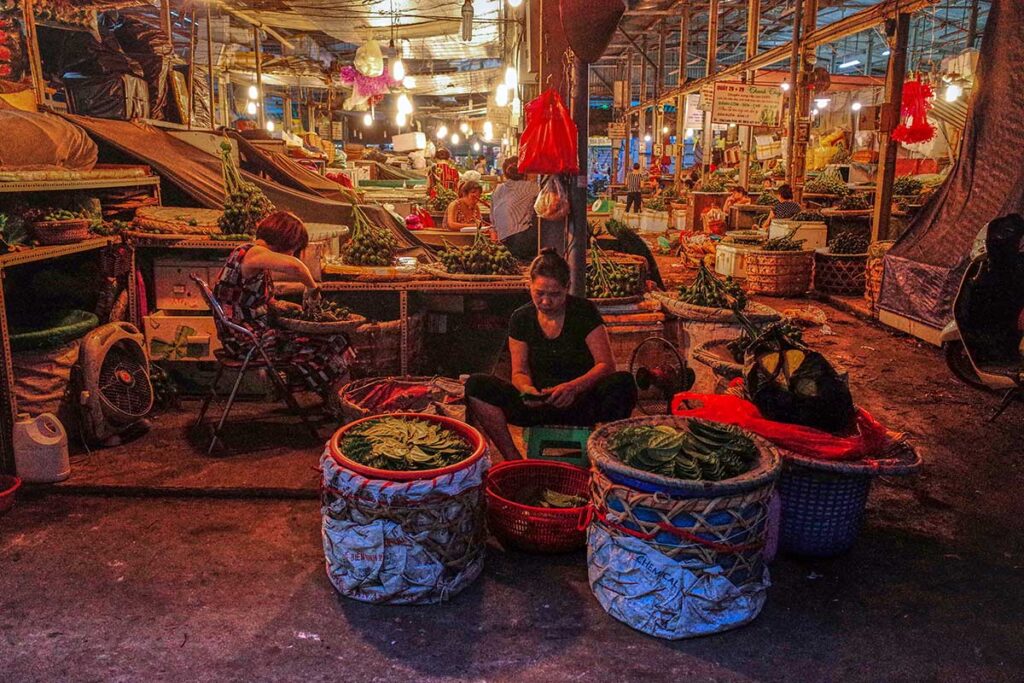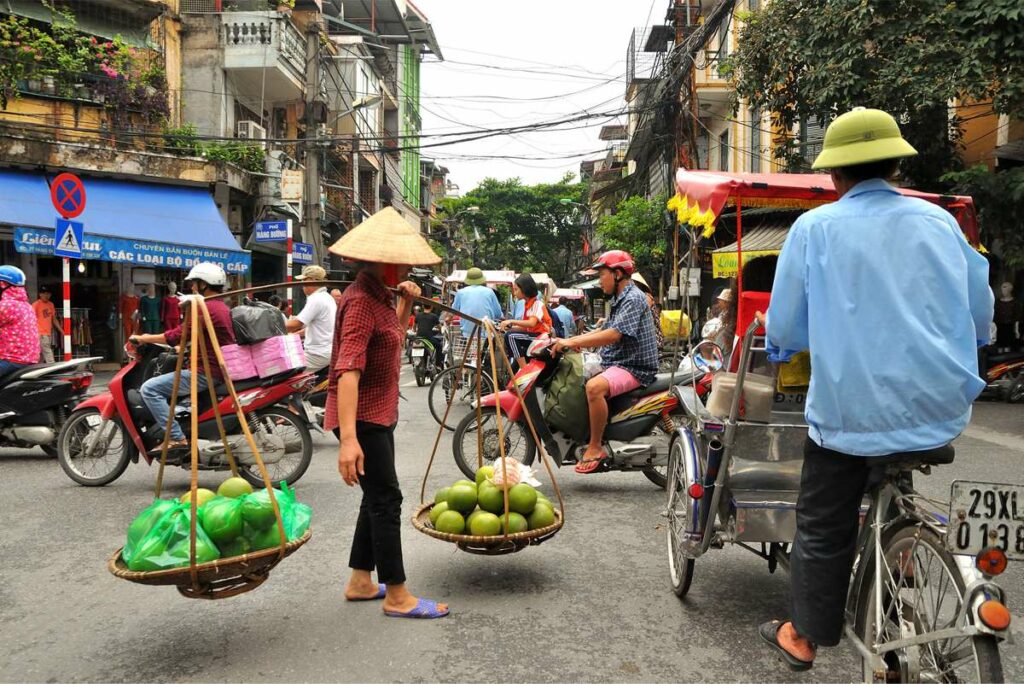What is Long Bien Market like?
Long Bien Market is not your typical tourist destination — it’s a gritty, no-frills wholesale market that runs through the night while the rest of Hanoi sleeps. This is where restaurant suppliers, small shop owners, and fruit vendors come to buy in bulk, not where you go to pick up souvenirs.
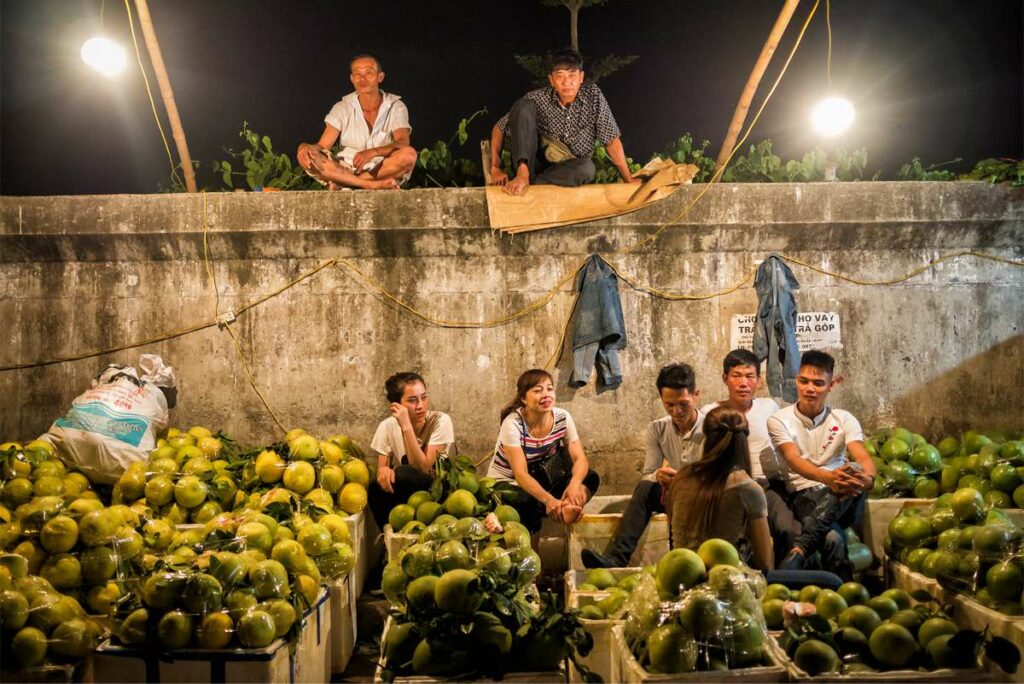
Tucked beneath the steel frame of the Long Bien Bridge and stretching along Yen Phu and Hong Ha streets, the market unfolds in open-air chaos, dim lighting, and the constant buzz of motorbikes, crates, and voices.
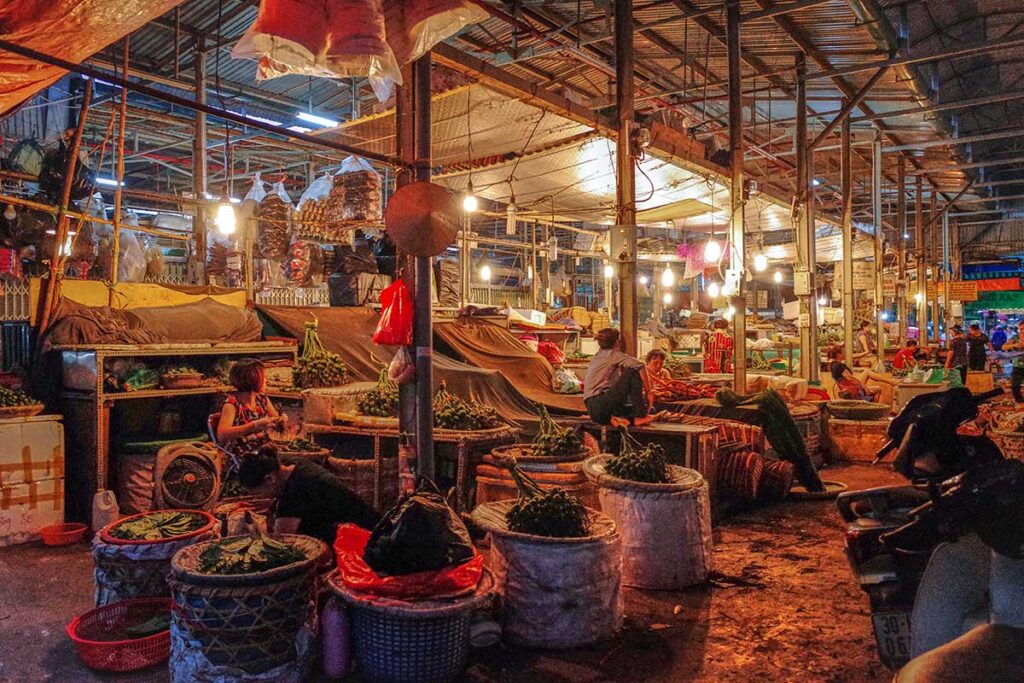
Expect a raw, energetic atmosphere that feels more like a supply chain in motion than a curated experience. It’s messy, loud, and fast-paced — but that’s exactly what makes it fascinating. Tourists are few and far between, and vendors are here to work, not entertain. If you’re curious about what fuels Hanoi’s daytime street stalls and eateries, this is where it all begins.
The market layout is loosely divided into overlapping zones:
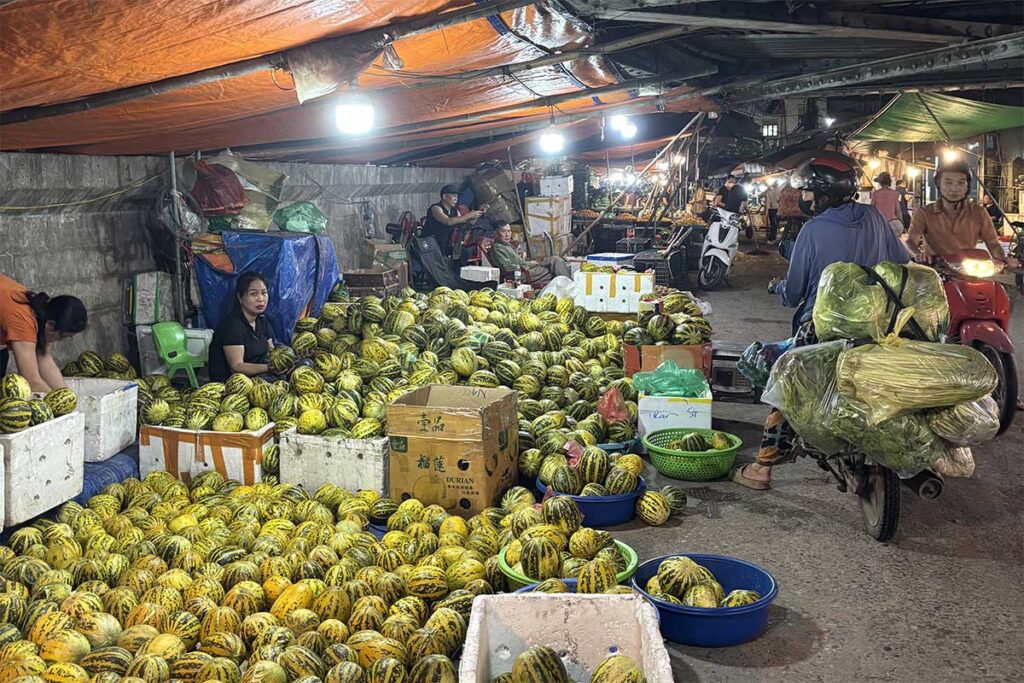
Fresh produce section: The largest and busiest zone, with crates of fruits and vegetables from provinces across Vietnam — from delta bananas to northern plums and lychees.
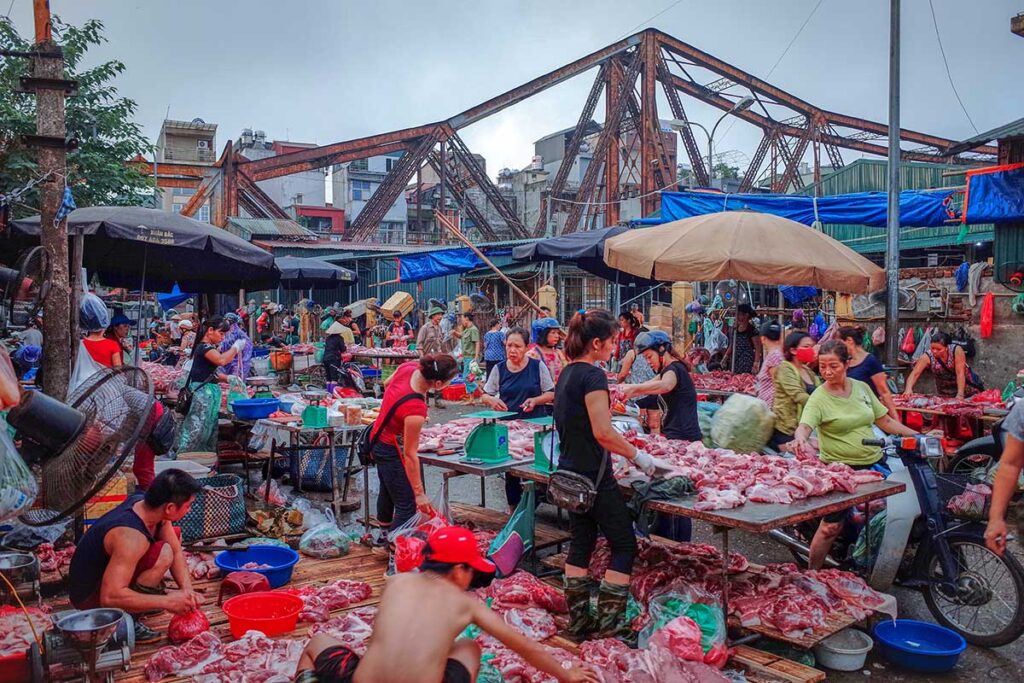
Seafood and meat stalls: Less orderly and more intense, this area includes everything from shrimp and squid to pig parts and blood — not for the squeamish.
Flower zone: Smaller and tucked toward one end, with bunches of fresh-cut flowers from Dalat and Moc Chau for florists and market sellers.
Street food pockets: Scattered food carts serve pho, crab noodle soup, and sticky rice to hungry porters and early risers.
Dry goods and bulk items: A quieter corner with bags of rice, beans, and other staples — usually handled quickly by repeat buyers.
It’s chaotic, but strangely efficient — a behind-the-scenes look at the city’s food economy.
History of Long Bien Market
Long Bien Market began as one of Hanoi’s key wholesale hubs, emerging in the late 20th century to serve the growing demand for fresh produce and food distribution across the capital. Its location just beneath the Long Bien Bridge, near the Red River, made it ideal for transporting goods into the city from surrounding agricultural provinces.
The market evolved alongside Hanoi’s urban development, expanding in scale and intensity as the city grew. Despite modernization and changing infrastructure, Long Bien Market remains a vital supply point for smaller markets, food stalls, and restaurants throughout the city — a gritty but essential part of Hanoi’s daily economy.
Highlights of visiting Long Bien Market
1. The produce chaos at 2 AM
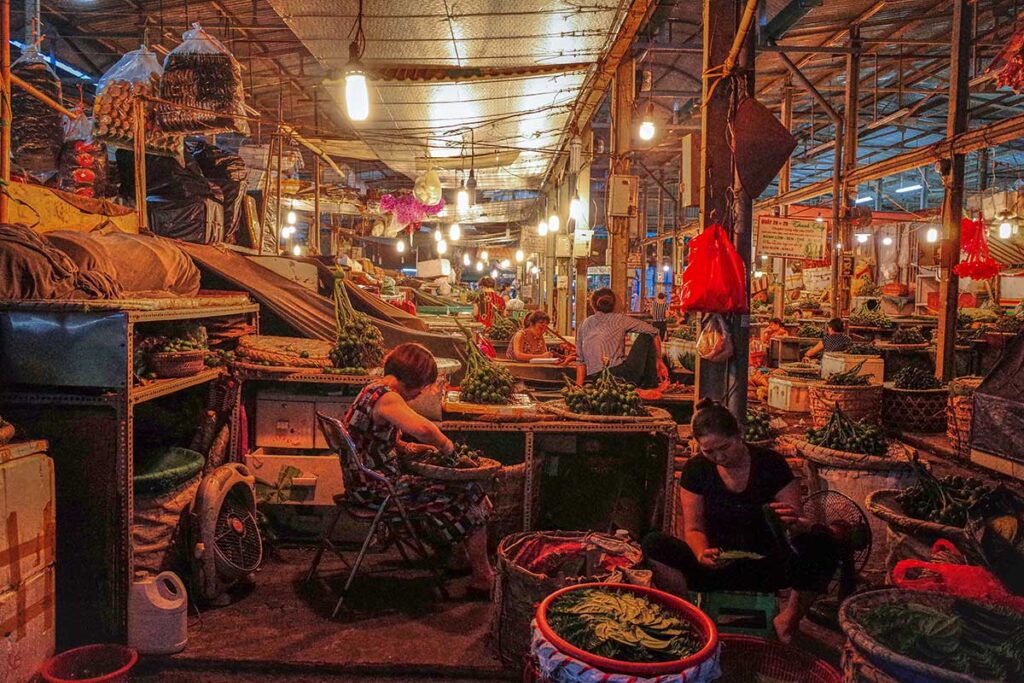
This is when Long Bien Market hits its peak. Around 2 AM, trucks loaded with fruits and vegetables from across Vietnam pour into the narrow alleys beneath Long Bien Bridge. Workers move fast — unloading crates, yelling prices, and striking quick verbal deals in the dark, humid air.
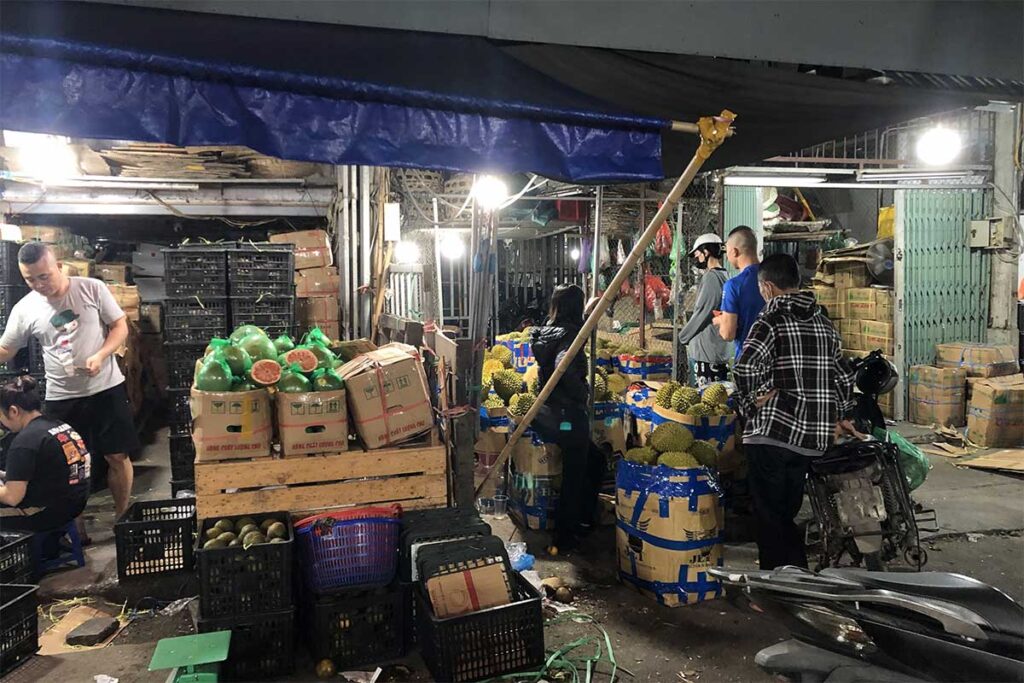
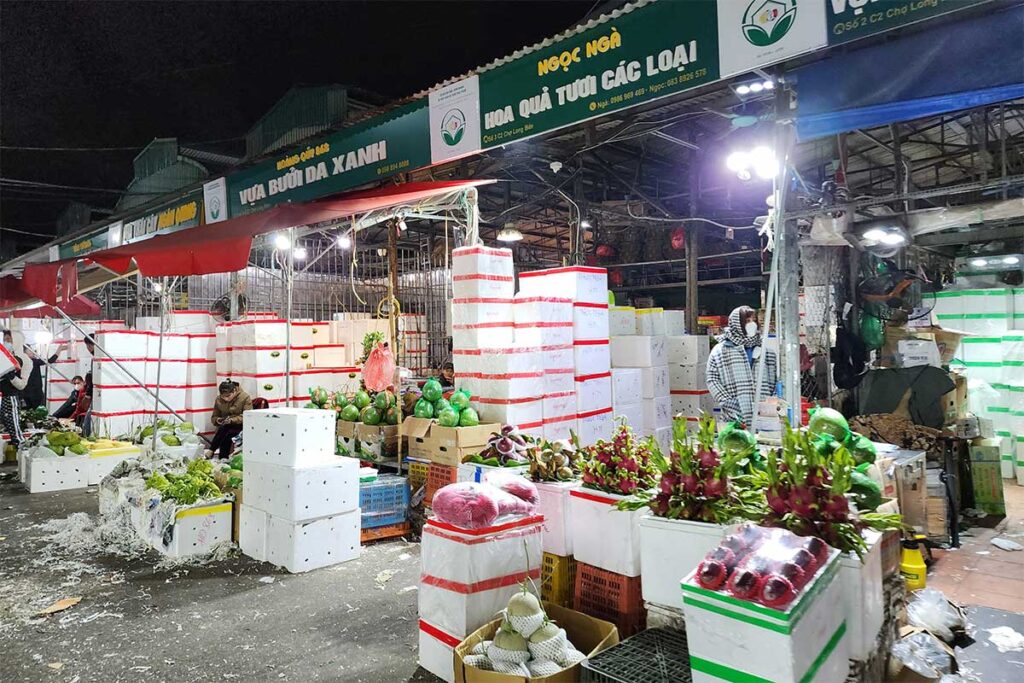
Most goods are sold in bulk to vendors preparing for the morning’s trade. It’s noisy, intense, and surprisingly well-coordinated despite the seeming chaos.
2. Late-Night street food stalls
Tucked along the market edges, a handful of street food stalls cater to laborers and night workers — but curious visitors are welcome too. You won’t find trendy cafés or Instagram spots here, just honest, local dishes like:
- Pho – hot, simple, and satisfying in the early morning hours
- Bun rieu – tangy crab noodle soup
- Banh gio – soft rice dumplings in banana leaf
- Mien tron – glass noodle salad, often with shredded chicken or pork
- Sticky rice (xoi) – served with savory toppings
- Banh da cua – crab noodle soup with flat rice noodles
Most bowls cost just 15,000–50,000 VND. Cleanliness varies, so follow the locals and look for busy stalls.
3. The local experience
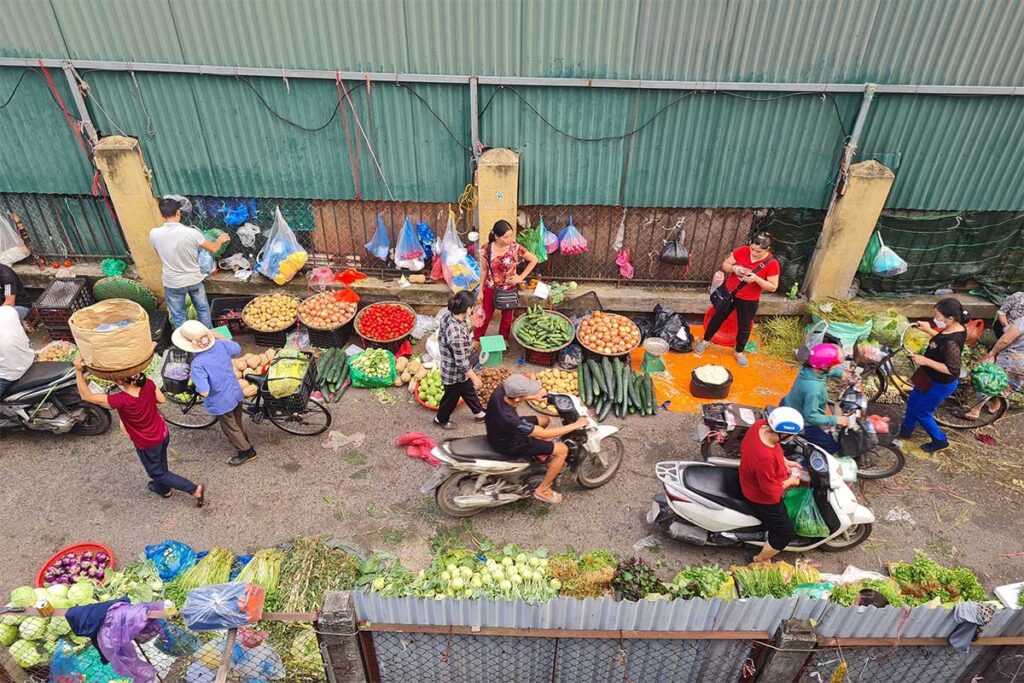
Long Bien Market is raw Hanoi — no signs in English, no curated tours, no one selling postcards. You’re stepping into a working space, not a tourist zone. Vendors expect quick transactions and often communicate with hand gestures, calculators, or nods. Bargaining is common but must be done politely. Expect to get a little dirty, hear a lot of shouting, and see Hanoi’s food chain in motion before most of the city has even had coffee.
4. Photography and Observation
For photographers and urban explorers, Long Bien Market offers gritty, atmospheric scenes — moody lighting, steam rising from soup pots, workers hauling crates through narrow gaps between motorbikes.
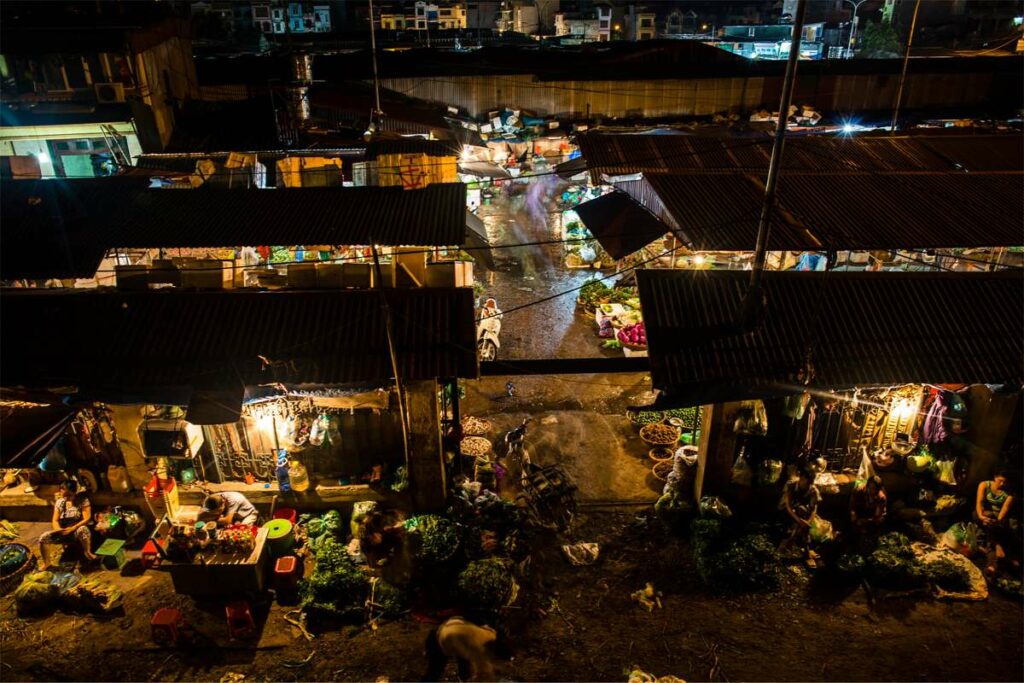
The best vantage points are from the bridge itself, or standing at one of the alley entrances where trucks unload. But be mindful: this is a work zone, not a photo shoot. Always ask before photographing people up close, don’t block paths, and stay out of the way of porters — they don’t stop for anyone.
Practical visiting information
Opening Hours
Long Bien Market operates nightly, typically from 10:00 PM until around 6:00 AM. Activity ramps up after midnight and peaks between 2:00 and 4:00 AM, when truckloads of produce arrive and the energy is at its most intense. By 6:30 AM, most vendors have packed up, leaving the area almost deserted except for leftover crates and cleanup crews.
Best Time to Visit
If you want to witness the full energy of Long Bien Market, aim to arrive between 2:00 and 4:00 AM. This is when the biggest shipments come in and the action is non-stop. Arriving later than 5:30 AM will feel like missing the show — most stalls will already be empty. Avoid visiting during the day; while technically open, the market is largely shut down and lacks the atmosphere that makes it special.
Location & Address
Long Bien Market is located beneath the Long Bien Bridge, with the main entrance along Yen Phu Street, near the intersection with Hong Ha Street in Phuc Xa Ward, Ba Dinh District. It’s just north of Hanoi’s Old Quarter — about a 10-minute walk from Dong Xuan Market and 15 minutes from Hoan Kiem Lake.
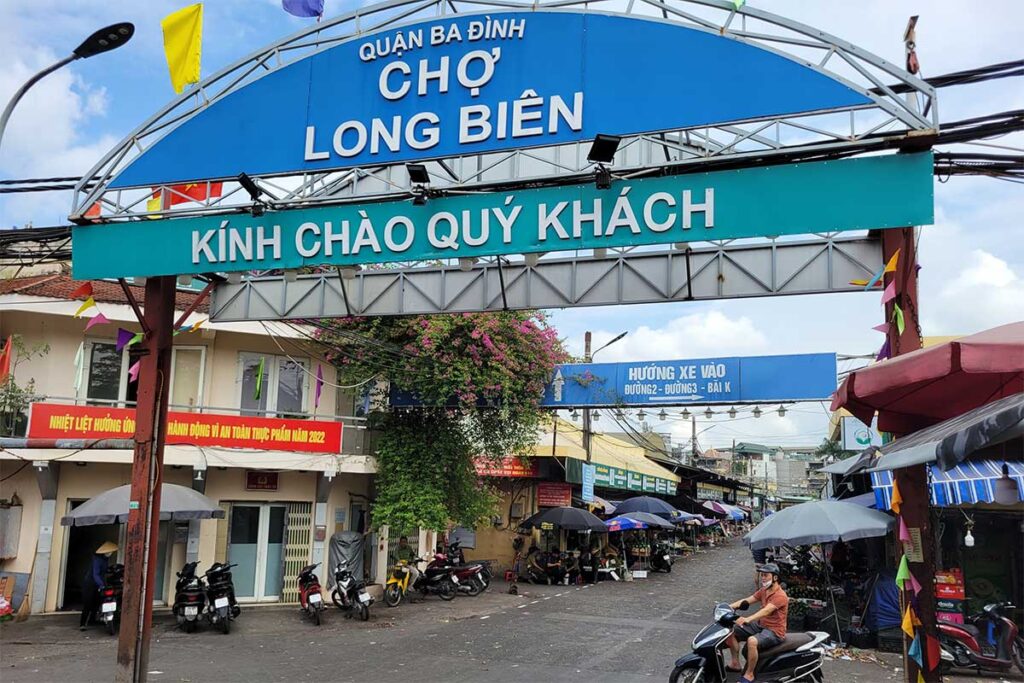
Although the market stretches over several alleys and loading areas, the most accessible entrance for visitors is from Yen Phu, where you’ll see activity and food stalls starting late in the evening.
How to get there
If you’re staying in the Old Quarter, Long Bien Market is close enough to walk — just 10 to 15 minutes from Hoan Kiem Lake or Dong Xuan Market. It’s safe to walk at night if you’re in a group or feel comfortable navigating dim streets, but be alert for uneven sidewalks and early-morning motorbikes.
For most visitors, the easiest and safest way to get there is by using a Grab car or Grab motorbike. Just type “Chợ Long Biên” or “Long Bien Market” into the app and set your drop-off point to Yen Phu Street, near the market gate under the Long Bien Bridge. Drivers are familiar with the area and will usually drop you right at one of the busiest entrances.
Taxi is also an option, though it’s best to have your destination written down or pinned on a map, as not all drivers speak English.
Tips for visiting Long Bien Market
Come at the Right Time
Timing makes or breaks your visit. To see Long Bien Market at its most dynamic, aim to arrive between 2:00 and 4:00 AM. This is when the big trucks come in, crates are being unloaded, deals are happening, and the atmosphere is alive. If you show up at 5:00 AM or later, much of the action will have died down. And during the daytime, the market feels almost deserted — messy, hot, and with little going on. For the real experience, early (or late) is everything.
Go with a local guide
While you can visit Long Bien Market on your own, having a local guide makes a big difference. They’ll help you navigate the chaos, translate or explain what’s happening, and take you to the right spots without getting in the way of busy vendors. It also allows you to ask questions and understand more about Hanoi’s food supply system. A good guide can even combine the market with other early-morning stops — like flower markets, old-school breakfast joints, or hidden corners of the city waking up.
Pro tip: Combine with Quang Ba Flower Market
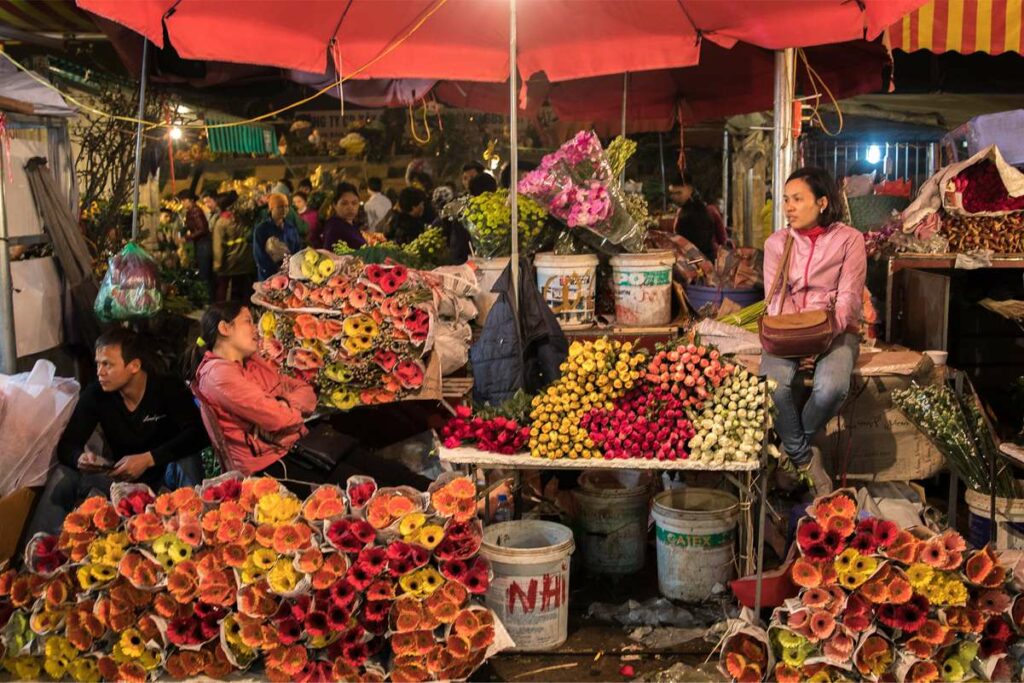
If you’re already waking up early, make it count by visiting Quang Ba Flower Market too. It starts around 3:00 AM and offers a completely different vibe — calmer, fragrant, and colorful. While Long Bien is about crates and chaos, Quang Ba is about roses, lilies, and bouquets being prepared for the morning trade. The two markets together show two very different sides of Hanoi’s economy before sunrise.
After both, grab a bowl of pho or a strong Vietnamese coffee — it’s a great way to wrap up an early adventure. For more ideas, check out our guide: Hanoi in the morning.
Other local markets in Hanoi
Interested in exploring more of Hanoi’s market culture? Here are a few more local spots worth visiting:
- Dong Xuan Market – One of the largest and busiest daytime markets, great for dry goods and textiles.
- Chau Long Market – A no-frills market for serious home cooks, with lots of raw ingredients and daily-life vibes.
- Hom Market – Traditional Hanoi atmosphere with fruits, vegetables, and local snacks.
Read more in our full guide: Best markets in Hanoi
Combining the Bridge and Market
Since Long Bien Market sits directly under the historic Long Bien Bridge, it’s natural to visit both — but their best visiting times don’t quite match up. The bridge is most scenic around sunrise or sunset, while the market is at its liveliest between 2:00 and 4:00 AM. That means if you explore the market early — say around 2:30 or 3:00 AM — you’ll finish well before sunrise, and there’s not much in the area to do while you wait.
You could visit the market around 3:30–4:30 AM, you’ll still catch plenty of activity and can easily continue up onto the bridge by 5:00 AM for views of the Red River as the city wakes up. Early morning here offers a peaceful contrast: the glow of sunrise, morning mist, a few food vendors setting up — and one of Hanoi’s best spots for quiet street photography or reflection before the city noise begins.
Pro tip: Early-morning itinerary with Quang Ba Flower Market
Want to make the most of your early wake-up call? Here’s a route that hits everything at the best time:
- 2:30–3:30 AM – Visit Long Bien Bridge first for a quiet, moody nighttime walk
- 3:45–4:45 AM – Head to Quang Ba Flower Market (about 15 minutes by car or Grab)
- 5:00 AM onward – Return to Long Bien Bridge for sunrise views and early-morning atmosphere
While it involves a bit of backtracking, the bridge lies directly on the return route back to the Old Quarter from the flower market — so you’re not going far out of your way. This plan lets you see two of Hanoi’s most authentic markets plus one iconic landmark — each at the ideal time.
Is Long Bien Market worth visiting?
Yes — if you know what you’re walking into. This isn’t a place for souvenirs, relaxed browsing, or curated experiences. It’s a working wholesale market where locals hustle through the night to feed the city by morning.
Visiting Long Bien Market means making an effort — either staying up late or waking up painfully early. It can be gritty, overwhelming, and confusing. But for travelers looking to step off the tourist trail and see real, unfiltered Hanoi, it’s one of the most memorable experiences you can have.
If you’re after comfort, skip it. But if you’re curious about the city’s pulse before sunrise, this market delivers.
